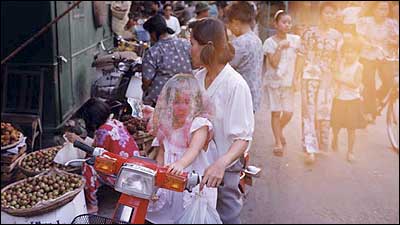
The Foodie
When Han Feng says she wouldn’t trade her day job as a fashion designer for a food career, you have to wonder. Feng won over her Jewish in-laws with a home-cooked Shanghai-style meal, counts chefs like Jean-Georges as her friends, and regularly travels the world in search of her next great meal. Her most memorable trip: Kyoto. “I went to a restaurant with no menu. They ask you how much you’ll spend, and I said $200. The first dish was one scallop, cut in half, with one strawberry on top of it. So sexy!” She’s checked Argentina, Hong Kong, Italy, and half the bistros in Paris off her gourmand’s life list. A glaring omission, she says: Southeast Asia.
Try Hanoi

So far, the relentless sweep of gentrification that is fast devouring ancient Asian streetways has happily spared the bustling old Colonial center of Hanoi just north of Hoan Kiem Lake. That’s where we’re headed. We’ve scarcely unpacked, and we’re off to claim a spot at the century-old Cha Ca La Vong, funky and faintly smoky from the burning braziers that come to the table with mild white fish simmering away in tumeric-yellow broth (that’s it, that’s all they offer). Dunk dill and cold noodles into the pan, then serve. Add fish sauce, sprinkle with peanuts, sip beer. Heaven.
It’s possible to spend hours, even days, exploring the thousand-year-old maze where each guild gave its name to a street, some only a block long—streets for silk, art, shoes, and gems, gravestones, herbal medicines, everything paper, and plumbing supplies. And in between, streets devoted to food. Like the one leading into Dong Xuan Market, where I find myself hunkered down on a tiny plastic stool inches above the gravel, marveling at crisp, just-made summer rolls. Street peddlers beckon us to taste bits of beef barbecued on a skewer, corn on the cob, or a bowl of unidentified nibbles atop noodles that has drawn a crowd and must be good. (Indeed, it is.) And everywhere, we sample the essential pho, an all-day soup. At Mai Anh, it will be pho ga, chicken-bone soup and rice noodles. Our favorite cantina, Dac Kim Bun Cha, ladles hot broth into a bowl, adding pork patties, bacon curls, and winter melon. And we must have their crispy crab rolls. Business is good—the owners wear jade on every finger.
Our favorite serious restaurant is Cay Cau in the De Syloia hotel, where the chicken with banana flower and big juicy crab in tamarind are so smartly done we don’t mind the musicians’ playing odd stringed instruments. Nam Phuong in a Colonial-era villa does greaseless spring rolls, sugarcane shrimp on skewers, and crab any number of ways—try it sautéed in the shell with onions. Locals and expats love Bobby Chinn on Hoan Kiem Lake for sophisticated Vietnamese fusion. New since my last visit, the innovative chef at Ly Club is generating buzz in a great Art Deco pile behind the Sofitel Metropole Hotel.
Walking is my way to see Hanoi. Lord knows we need the exercise and can catch the snacks along the way. Circle the park, saying no to 100 vendors selling postcards, pastries, and The Quiet American. Watch old people exercise. See Ho Chi Minh lying beatified and illuminated under glass in his sternly guarded mausoleum. Shopping gets better every year. Lacquerware, ceramics, quilted Chinese jackets for kids, silk pajamas—I regret only what I didn’t buy. Let ex–New Yorker Suzanne Lecht at Art Vietnam be your art guide; check out Salon Natasha for eclectic contemporary art. The new Sheraton Hotel has helped bring trendy galleries and shops to Xuan Dieu Street on West Lake, and at the Vine Wine Boutique Bar & Café, a California chef skillfully blends an upscale Western menu with coffee-shop casual. If you miss home, there’s bagels, cream cheese, and lox on Sunday.
The Sofitel Metropole Hotel offers cooking classes and a daily Vietnamese street-food lunch buffet (844-8266-919; from $124 per night).